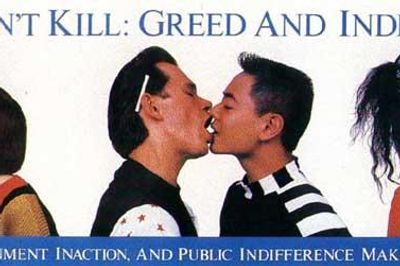By Liz Massey, Aug. 28, 2014.
I was raised in a household where appreciation of the arts was a daily reality, not a distant ideal. My earliest memories are of singing folk songs around the piano in our home. My grandmother celebrated America’s Bicentennial in 1976 by writing a historical novel set during the Revolutionary War. My father’s favorite hobby is arranging and composing music. My mother does watercolor and small craft projects for fun. My oldest sister sang in community opera productions for decades; my other sister’s favorite classes in high school were art and dance. I write, sing, play musical instruments and dabble in sketching and cartooning.
With a background like that, I’m probably more sensitive than most people regarding the way in which artists are stereotyped by the larger culture. Depending who you ask, we artists are prissy elitists, impractical dreamers, or wildly amoral degenerates. And LGBT artists have gotten tarred with this stereotype brush, a fact only complicated by the ways in which we’re stereotyped for just being gay.
Art’s association with unpleasant stereotypes may stem from the fact that making art has long been detached from its roots. In the really, really olden days (as in, prehistoric times), “art” was generated as people crafted tools that ensured their survival, conveyed directions to each other on the best way to live and made sense of this shared experience of being alive. It wasn’t a frill in those days — just like clean drinking water, adequate food and sufficient shelter, art was on the short list of human “must haves.”
Given those truths, I’d like to suggest that the arts are also a “must have” for every LGBT person, as well as our allies. Our community has a unique relationship to the arts, one that we have used to create social and cultural change.
Since Stonewall, LGBT art has been intertwined with our activism. In the late 1980s, the artist collective Gran Fury published a poster with male, female and mixed-sex couples kissing, which bore the text “Kissing doesn’t Kill: Greed and Indifference Do.” It was a powerful, and at the time a somewhat shocking statement about the government’s indifference to the AIDS crisis. The activist group ACT-UP also used theater-style tactics to prod the government and Wall Street into developing effective drugs to treat the illness, with “die-ins” and other actions pointing out the consequences of inertia on the issue.
So, LGBT activists need artists, and vice versa. Some of the reasons our activism and our art must walk hand in hand include:
Facts rarely speak for themselves.
The arts give context to data — they clothe it in story and make it dance.
The arts make advocacy through creative disruption possible.
A recent example of this was the “glitter-bombing” of former presidential candidate Rick Santorum and other antigay personalities. This arts-based tactic makes a colorful, nonviolent statement about the target’s attitudes toward and treatment of LGBT people.
Art asks questions and presents alternative possibilities.
Some of those alternatives are nightmares, others are utopian paradises. All of them require a thinking, feeling response, and not blind acceptance of wisdom from the government, a religion or a cultural tradition.
The arts change culture at the subterranean level.
Good paintings, moving pieces of music, and powerful works of literature shift perspective as they entertain. They allow the “unspeakable” to be spoken, so that by the time of a revolutionary moment such as Stonewall, the words to describe a new way of looking at an issue are already on everyone’s lips.
Art demonstrates that humans still matter.
John Maeda, former president of the Rhode Island School of Design, asserted in an essay in Wired Magazine that “art shows us that human beings still matter in a world where money talks the loudest … Artists ask the questions that others are afraid to ask and that money cannot answer.” It can cut through hopelessness and helplessness, and prove that the power of the human heart, expressed artistically, has the potential to change the world.
There is one other thing that makes art a perfect tool of activism: it’s something everyone can participate in. Whether it’s supporting independent artists on the rise, helping art-makers make a living by buying their work or spreading the word about them, or making your own art, you don’t need a degree or excess talent to express yourself as an LGBT artist. All you need is the will and the motivation to act.
